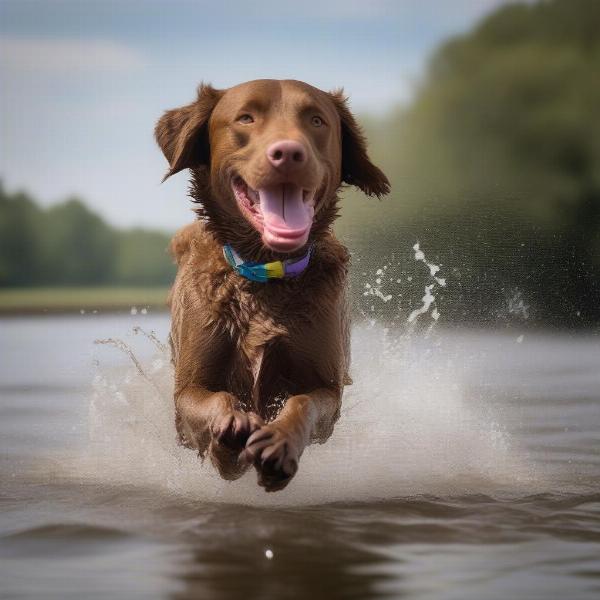Chesapeake Bay Retriever rescue dogs offer a wonderful opportunity to welcome a loyal and loving companion into your home. Whether you’re an experienced Chesapeake owner or considering this breed for the first time, adopting a rescue can be a rewarding experience. This guide will cover everything you need to know about finding, choosing, and caring for a rescued Chesapeake Bay Retriever.
Understanding the Chesapeake Bay Retriever Temperament
Chesapeakes are known for their intelligence, loyalty, and strong work ethic. They were originally bred as hunting dogs, specifically for retrieving waterfowl in the icy waters of the Chesapeake Bay. This heritage has given them a strong, independent nature and a love for the outdoors. They are active dogs that require plenty of exercise and mental stimulation. Understanding these traits is crucial when considering a rescue Chesapeake. They may have experienced past trauma or neglect, which can influence their behavior.  Chesapeake Bay Retriever playing fetch in the water
Chesapeake Bay Retriever playing fetch in the water
Finding a Reputable Chesapeake Bay Retriever Rescue Organization
Finding a reputable rescue is the first step in your adoption journey. A good rescue organization will prioritize the well-being of their dogs and ensure they are placed in suitable homes. Look for organizations that:
- Conduct thorough screenings of potential adopters.
- Provide complete medical histories for their dogs.
- Offer support and guidance throughout the adoption process and beyond.
- Are transparent about their operations and finances.
A thorough search online and contacting local breed-specific rescue groups can help you find the right organization.
Preparing Your Home for a Rescued Chesapeake
Chesapeakes are energetic dogs that need space to roam and play. A fenced yard is ideal, as is access to water for swimming. Ensure your home is dog-proofed and that you have the necessary supplies, such as food and water bowls, a comfortable bed, and toys. Consider the potential costs associated with owning a Chesapeake, including vet care, food, and grooming.
Meeting and Evaluating a Potential Rescue
Once you’ve found a rescue organization, you can begin the process of meeting potential dogs. Be patient and open-minded, as the perfect match may not be immediately apparent. When meeting a Chesapeake, observe their behavior and temperament. Look for signs of friendliness, curiosity, and a willingness to interact. Ask the rescue staff about the dog’s history, personality, and any known behavioral issues. dogs like to swim
The Adoption Process and Bringing Your Chesapeake Home
The adoption process typically involves an application, home visit, and interview. Be prepared to answer questions about your lifestyle, experience with dogs, and ability to provide a loving and stable home. Once approved, you’ll finalize the adoption and bring your new companion home. The first few days can be a period of adjustment for both you and your rescued Chesapeake. Be patient, understanding, and provide plenty of love and support. water dogs for sale salamander
Caring for Your Rescued Chesapeake Bay Retriever
Providing a nurturing environment is essential for a rescued Chesapeake. This includes regular exercise, a balanced diet, mental stimulation, and socialization. Be prepared to invest time and effort in training and building a strong bond with your dog. water loving dogs for short nyt
Common Challenges and Solutions with Rescued Chesapeakes
Rescued Chesapeakes may come with pre-existing behavioral issues, such as separation anxiety, fear, or aggression. Be prepared to address these challenges with patience, consistency, and professional guidance if needed. Working with a certified dog trainer or behaviorist can be invaluable. dogs that look like labs
Conclusion
Adopting a Chesapeake Bay Retriever rescue dog can be an immensely rewarding experience. By understanding the breed’s temperament, finding a reputable rescue organization, and providing a loving and supportive environment, you can give a deserving dog a second chance at happiness and find a loyal companion for years to come. amber dog breed
FAQ
- Are Chesapeake Bay Retrievers good family dogs? Chesapeakes can be wonderful family dogs, especially in active households with older children. Early socialization is key.
- How much exercise does a Chesapeake Bay Retriever need? Chesapeakes are high-energy dogs that require a significant amount of exercise, including swimming, running, and retrieving.
- Are Chesapeake Bay Retrievers easy to train? Chesapeakes are intelligent but independent, which can make training challenging at times. Positive reinforcement methods are recommended.
- What health problems are common in Chesapeake Bay Retrievers? Like all breeds, Chesapeakes are prone to certain health issues, including hip and elbow dysplasia, eye problems, and certain types of cancer.
- How do I find a reputable Chesapeake Bay Retriever rescue? Research online, contact local breed-specific rescue groups, and ask for recommendations from veterinarians or other dog professionals.
- What should I expect when bringing a rescued Chesapeake home? Be prepared for an adjustment period. Your new dog may be shy, anxious, or exhibit other behavioral issues. Patience, love, and consistency are key.
- Where can I find more information about Chesapeake Bay Retrievers? The American Chesapeake Club is a great resource.
ILM Dog is a leading international website dedicated to providing expert advice and resources for dog owners worldwide. We offer a comprehensive range of information on dog breeds, health, training, nutrition, and much more. Whether you’re a new dog owner or a seasoned expert, ILM Dog can help you navigate every aspect of dog ownership. Contact us today for more information: Email: [email protected], Phone: +44 20-3965-8624.